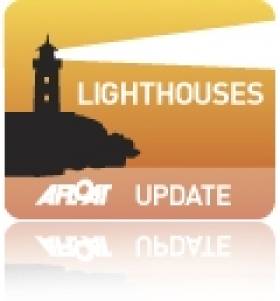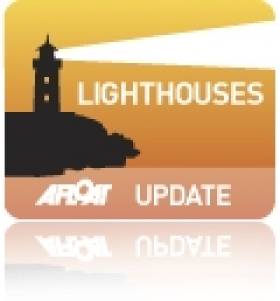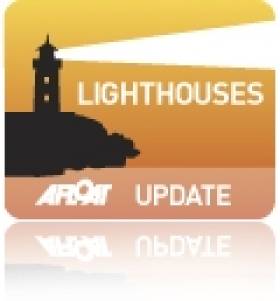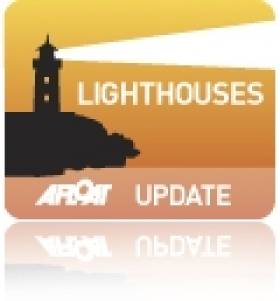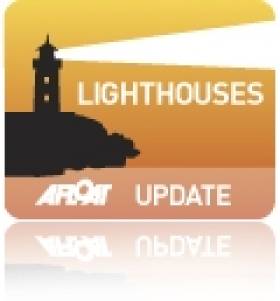Displaying items by tag: lighthouses
Very Rare Lighthouse Optic Set for Display in Titanic Quarter
#RareOptic - Commissioners of Irish Lights and Titanic Foundation have been awarded a first-round pass from the Heritage Lottery Fund for saving, restoring and displaying the old optic from Mew Island Lighthouse, a very rare hyper radial Fresnel lens, in Belfast’s Titanic Quarter.
The award, along with early support from Ulster Garden Villages, will allow the project to progress to the second stage of the HLF application process. If successful, the optic will be restored and housed in a new interpretive structure, made to resemble a lighthouse lantern room where it would add an iconic element to the Titanic Quarter public realm. With free public access it will tell the story of lighthouses, their technological development, their light keepers, and their role in the proud maritime & industrial heritage of Belfast and Ulster.
Mew Island lighthouse, on the outermost of the Copeland Islands, is one of the tallest lighthouses in Ireland. It is an important Aid to Navigation at the southern entrance to Belfast Lough, built at a time when Belfast was the world-centre of linen, ship-building and rope-making, and one of the most important ports in the World.
The optic is the internal apparatus which gave Mew Island Lighthouse its traditional revolving light. Made in Paris in 1887, it is possibly the largest ever constructed, at a staggering 7 metres high, 2.6 metres wide and weighing up to 10 tonnes. The optic is one of 29 of the largest optics ever made, with only 18 still in existence across the world. It’s one of only 3 similar optics in Ireland, none of which are now operational.
Over its life, and as technology has developed, Mew Island optic was lit with town-gas (derived manually on the island from coal), vaporised paraffin, and electricity. Kerrie Sweeney, Chief Executive of Titanic Foundation commented, ‘This remarkable object is an amazing piece of industrial and scientific heritage and our proposal has really captured the public’s interest. We’ve received letters of support from the World Lighthouse Society as well as the UK Committee of the International Year of Light 2015.
‘We are delighted to have secured support from Heritage Lottery and Ulster Garden Villages; this is a once in a lifetime opportunity to save and restore an artefact of national and international significance and create a legacy Belfast landmark which will inspire future generations’
Paul Mullan, Head of HLF Northern Ireland, said: “The Mew Island optic is of great scientific and heritage value so we were delighted to receive these ambitious plans to restore and put it on public display. The project has the potential to create a truly unique and wonderful heritage attraction in the heart of Belfast’s maritime quarter and we look forward to receiving the full proposals in due course.”
Irish Lights, recognising the importance of the optic within Belfast’s maritime heritage, have been working for over 3 years to find a suitable home for the optic. Through the partnership with Titanic Foundation, the charity that owns Titanic Belfast, they are delighted that Mew Island Optic will be located in Belfast.
Barry Phelan; Irish Lights Project Engineer said; “ This project will ultimately develop a brand new tourist attraction in Belfast, and will provide a permanent home for the magnificent Mew Island Lighthouse Optic beside a very worthy neighbour - Titanic Belfast. The project will also shine a light on the wonderful Great Lighthouses of Ireland nearby, which offers you a chance to stay in, visit, or learn about lighthouses and the Irish Lights at; Blackhead Antrim, St. John’s Point Down, Rathlin Island, or further afield.”
The optic, which was recently replaced by a modern solar-powered, flashing LED in March 2015, has already been transferred from Mew Island to the Irish Lights’ offices in Dun Laoghaire where they are carrying out initial restoration works.
Golden Birthday for Dublin Bay Sentinel: Kish Lighthouse
#KishLight@50- The Commissioners of Irish Lights today welcomed the visit of President Michael D Higgins and Mrs. Sabina Higgins to join the Board and staff to say 'Happy Birthday' as the Kish Lighthouse celebrates 50 years of service on the 9th November 2015.
Imagine what that means.
How many millions of passengers have watched the Kish fade over the horizon as they emigrated to Britain and beyond? How many have watched its welcoming flash guide them safely back home to Ireland?
95% of everything we use arrives and leaves by sea. Imagine the cargoes made safe by the Kish Light. The agricultural products, the machinery, the building materials, the household goods, the cars, the clothes; every single staple of our lives has passed the great guiding lighthouse on the Kish.
As a witness to social history the Kish has seen significant change. Containerisation has changed the ships and crews, air travel has changed the passenger numbers, fuel costs have allowed it witness the growth and subsequent decline of fast vessels such as Jetfoil and HSS. (See, Afloat's latest report on the former Stena Explorer currently heading for Turkey).
Consider the lives of the Lighthouse Keepers who lived on the tower until automation in 1992.
The Kish Lighthouse is not just a seamark but a very significant engineering landmark of its day. The lighthouse replaced a lightship which was one of a series of such vessels that marked the Kish Bank since 1811 – meaning that there has been a continuous light on the Kish for the 204 years.
Kish Bank Lighthouse Celebrates 50th Anniversary Today
#KIshLight@50 - One of Ireland’s most famous and unique lighthouses, the Kish Bank Lighthouse off Dublin Bay, celebrates its 50th anniversary today having been commissioned into service on 9th November 1965, writes Jehan Ashmore.
At 31m high, the lighthouse which is an iconic symbol on the Dublin Bay horizon replaced a lightship understood to have been the Gannet. On that same day five decades ago the lightship was withdrawn and the first flashes were exhibited by the new lighthouse.
A light to ward off seafarers from the dangerous sands of the Kish Bank can be first traced back to more than 200 years ago. This earliest light was exhibited on 16 November 1811 which involved several small vessels of just over 100 tonnes each to share duties. Crews were tasked in using a floating light.
For the last half-century, the Kish Lighthouse located some 7 nautical miles offshore of Dun Laoghaire Harbour, from where the structure was built, has continued to provide the role as an important aids to navigation to seafarers.
In addition the Kish Lighthouse, albeit of Swedish design represents a significant moment in Ireland’s marine engineering heritage given the majority of the work was carried out by an Irish labour force.
The design origins of the Kish Lighthouse began in the early 1960’s as the Commissioners of Irish Lights (CIL) considered using a platform similar to those used as oil rigs for lighthouses purposes. Stemming from this nine engineering firms were asked to submit design tenders for such a lighthouse. The Swedish firm of Messrs Christiani & Nielsen Ltd was selected.
Their design was not for a steel platform like an oil rig but a concrete structure designed to last for at least 75 years and based on the lines of similar yet smaller models from Sweden. The reason for a larger version for the Kish Bank was so to cope with the rougher sea conditions of the Irish Sea.
Construction took place near St. Michaels Wharf (site of the former Stena HSS ferry terminal). Built of reinforced concrete in the form of a circular caisson, from within a concentric design included from a tower that together was floated out by tugs from Dun Laoghaire Harbour on 29 June 1965 (see footage above).
The lighthouse structure was sunk onto the Kish Bank from where a level platform of stones had previously been prepared by divers and buoyed by the Commissioners of Irish Lights tenders. The operation to raise the tower which was telescoped to its fullest extended height took almost a month to complete on 27 July.
For just over a quarter century, the white tower with its distinctive red band and topped off with a helicopter pad, was manned with a crew of three. The tower is a self-contained unit of 12 floors for keepers' quarters, storage, a generator, radio equipment and of course the lantern.
Crew were transferred in rough weather to the lighthouse by winching in a cradle pod from the lighthouse tender ship. Such practices were discontinued as the lighthouse notably was automated in 1992, ending another chapter in the history of Irish lighthouse-keepers.
Over the years the character of the light has varied. Currently the character is: Fl (2) 20s. 24 hour light which gives a range of 22 nautical miles. The actual height of the light at MHWS is of 29 metres.
Occasionally, the CIL’s aids to navigation tender, ILV Granuaile can be seen departing her homeport of Dun Laoghaire Harbour to carry out maintenance duties on the Kish Lighthouse.
Kish Lighthouse Exhibition & Lecture Celebrates 50th Anniversary
#KishLight@50– An exhibition of the 50th Anniversary of the commissioning of the Kish Bank Lighthouse off Dublin Bay, one of Ireland’s most unusual lighthouses, is currently on at the National Maritime Museum of Ireland (NMMI) in Dun Laoghaire.
Lighthouse Exhibition
The exhibition from Lightships to Lighthouse will also look in to the future is in conjunction with Captain Robert McCabe of the Commissioners of Irish Lights.
Lighthouse Lecture
In addition to celebrate the impressive structure of the lighthouse which was completed five decades ago on the Kish Bank, a two-hour lecture is take place next Thursday, 12 November.
The lecture “Kish Lighthouse –Before the Build” is to be co-presented by Brian Kelly and Eoghan Lehane.
Tickets cost €10.00. For more details including other events and in general about the NMMI, click here.
#LighthouseGrant - A grant of €299,000 was announced by Minister of State for Tourism, Michael Ring TD last week via the Fáilte Ireland Capital Programme, to the Commissioners of Irish Lights.
The grant is to develop a new visitor facility building on a site adjacent to Fanad Head Lighthouse. The project will incorporate a new car park as well as facilities for visitors, a ticket desk and an interpretation area.
Fanad Head Lighthouse is located in Co. Donegal on the eastern shores of the Fanad peninsula in an area recognised for its scenery and has been designated a Signature Discovery Point within Fáilte Ireland's Wild Atlantic Way initiative.
The Minister Ring commented: 'While recent technology advances mean that much of the old physical infrastructure at lighthouse stations is no longer required for core operations, the Commissioners of Irish Lights is to be commended for recognising that these properties are of important heritage value and preserving them as a tourism asset. Today's grant will allow Fanad Lighthouse to fully play its natural part as a truly spectacular stop along the Wild Atlantic Way'.
"The lighthouse itself is due to open to visitors this summer and will offer a unique visitor experience as well as provide an insight into the role of lighthouses in Ireland's past, as well as the lighthouse keeper's way of life. Visitors will have access to the top of the lighthouse with unsurpassed views of the Atlantic and the surrounding coastline. It will be a great asset to the region."
Fáilte Ireland CEO Shaun Quinn emphasised: 'We are more than happy to invest in this project and we believe that it will significantly build on the experience for visitors to this part of Donegal. The project is a perfect fit for the Wild Atlantic Way, which continues to develop and evolve, and an attraction such as Fanad resonates very much with both the 'culturally curious' and 'great escapers' – those overseas market segments to which the Wild Atlantic Way particularly appeals'
The nvestment follows a recent €500,000 refurbishment of Fanad Lighthouse by the Commissioners of Irish Lights, who have also redeveloped the former lighthouse keepers' houses into three self-catering units.
In addition, the Commissioners recently launched a new initiative entitled the Great Lighthouses of Ireland partnership. This initiative will bring together 12 lighthouses in Ireland and Northern Ireland and includes the marketing, preservation and conservation of our important maritime and lighthouse heritage.
The partnership was created to deliver an experience that is motivating and inspiring and fully leverages the Wild Atlantic Way's potential.
Tuskar Rock Lighthouse Celebrates 200th Birthday
#Tuskar200th – The Tuskar Rock Lighthouse off Ireland's south-east coast celebrates its 200th anniversary this year.
The lighthouse perched on the Tuskar Rock 7 miles off Co. Wexford is a familar sight to those taking ferry services in and out of Rosslare Harbour.
For two hundred years the lighthouse has helped provide safe navigation to mariners and sailors alike since its light was first exhibited on 4 June 1815.
The white tower is topped with a light that operates at night and in poor visibility during daylight hours.
Paraffin vapour burners were the light source until the light was converted to electric on 7th July 1938.
Electricity allowed the use of a 3000 W lamp giving two white flashes every 7.5 seconds.
On 31st March 1993 the lighthouse was converted to automatic operation and the keepers were withdrawn from the station.
The station is in the care of an Attendant and Assistant Attendant and the aids to navigation are also monitored via a telemetry link from the Commissioners of Irish Lights headquarters in Dun Laoghaire.
There is a much more detailed history of the lighthouse courtesy of Irish Lights which has dedicated a page on the their website here.
#Lighthouses - Lighthouse keeping is a 'lost tradition' in Ireland as the coastal network of Irish lights has converted to automation.
But there's still one last holdout, as the Journal.ie reports – not to mention the many former lighthouse keepers who have a lifetime of stories to share.
One of them is Gerald Butler, who today serves as attendant keeper at Galley Head lighthouse, included in the new Great Lighthouses of Ireland tourism initiative.
But his career – which began in 1969 at the age of 19, following his family's maritime leanings – previously took him to nearly every lighthouse in the State, including the isolated Fastnet Rock.
Sadly it's a profession that Ireland will never see again upon the retirement of Ireland's last keeper at Hook Lighthouse in Co Wexford.
“Once the era changed and the light keepers were gone the tradition went with them,” said Butler, who thinks what's "most important now is to preserve the history and preserve the heritage."
TheJournal.ie has much more on the story HERE.
When Irish Lights Are Shining in the Scilly Isles
#IrishLightsScilly – ILV Granuaile, the Commissioners of Irish Lights aids to navigation tender is understood to have carried out work for the first time within waters of the Isles of Scilly, writes Jehan Ashmore.
The tender's call in this week of St. Patrick's Day followed a departure from Irish waters in which she has responsibility around the entire coast of this island.
It was when she headed through St. Georges Channel is where she passed in the opposite direction the containership Coronel. The only vessel that operates between the Irish and Welsh capitals had departed Cardiff bound for Dublin.
ILV Granuaile has worked previously off the UK's South West coast but prior to this area she headed into the Bristol Channel to call into Swansea Docks where Trinity Lights have a depot in King's Dock. Likewise of Irish Lights, the general lighthouse authority (GLA) of Trinity House has responsibility for the safety of shipping and mariners in waters off England, Wales and the Channel Islands.
Following an overnight call, she was off Porthcawl. She then took a longer passage across the Bristol Channel to pass off Ilfracombe and offshore of the estuary leading to Appledore. This is where the Navy Service latest newbuild OPV90 was built by Babcock Marine. As reported before, James Joyce had completed recent builders sea-trials.
So why was ILV Granuaile working off the Scilly Isles, the reason is that one of the trio of Trinity House vessels, THV Patricia is undergoing her special five-year drydock in Hull. Last year ILV Granuaile underwent a more extensive 15 year Special Survey and Drydocking' at Cork Dockyard.
During her Scilly stay and offshore of Hugh Town on the largest island is where the main freight-only cargship, Gry Maritha was operating.
Both vessels this afternoon departed for the mainland, with the cargoship calling within the small confined dock of Penzance Harbour. Whereas the Irish lighthouse tender took up a position offshore of the Cornish port.
In January, Northern Lighthouse Board, the third GLA, deployed NLB Pole Star that involved a brief call to Dun Laoghaire Harbour. The call of the tender which otherwise has juristriction along with NLB Pharos of Scottish and Manx waters was concurrent to the 'Granuaile' making a more recent call to Cork Dockyard last month.
Second 'Spar' Trial Buoy Deployed on The Irish Sea
#SPARbuoys – The second of a pair of Finnish Spar tube type buoys has been deployed by the Commissioners of Irish Lights at the Bennet Bank station on the outer fringes of Dublin Bay,writes Jehan Ashmore.
ILV Granuaile, the aids to navigation tender carried out the deployment on Tuesday, a day after the first Spar buoy (a type used in the Baltic Sea) was deployed further south in the Irish Sea at the West Blackwater station off the Wexford coast.
CIL in co-operation with Meritaito Ltd, a Finnish state company are carrying out a comparison programme for performance and survivability tests on the spar buoys at the two Irish Sea stations and which are part of the Dublin Bay Digital Diamond Project.
The slim profile of Spar buoys, are particularly well suited to the Baltic's ice conditions, though they can suffer from conspicuity problems when compared with conventional buoys.
By deploying the Spar buoys, the Irish Sea trials will determine visible and radar conspicuity performance of the slimmer spar structures in comparison to the profile of the existing conventionally shaped buoys.
Trails are expected to run for 12 months and mariners are advised to maintain a safe distance from these buoys during the trial timeframe.
The Spar buoys are of the same light and daymark display as those of the existing buoys will be established in close proximity to both of the Irish Sea stations.
To consult the Notice to Mariners, showing Spar buoys locations, CLICK HERE.
Finnish Baltic Sea 'Spar' Buoy Deployed On Irish Sea Trials
#BalticSPARbuoys – The first of two Finnish 'Spar' tube type buoys was deployed in the Irish Sea yesterday by the Commissioners of Irish Lights as part of a trial comparison programme of these buoys normally used in Baltic Sea ice-flow conditions, writes Jehan Ashmore.
As previously reported on Afloat.ie last May, CIL announced its association with a Finnish state-owned company Meritaito Ltd to carry out performance and survivability tests on the spar buoys at two Irish Sea stations. The trials are part of the Dublin Bay Digital Diamond Project.
The first station to be deployed a Spar Buoy was at the West Blackwater off Co. Wexford which involved the CIL's aids to navigation tender ILV Granuaile, recently returned from dry-dock following a spell in Cork Dockyard.
The slim profile of Spar buoys are particularly well suited to the Baltic's ice conditions, though they can suffer from conspicuity problems when compared with conventional buoys.
By deploying the Spar buoys, the Irish Sea trials will determine visible and radar conspicuity performance of the slimmer spar structures in comparison to the profile of the existing conventionally shaped buoys.
The trails are expected to run for 12 months and mariners are advised to maintain a safe distance from these buoys during the trial.
The Spar buoys are of the same light and daymark display as those of the existing Irish Sea buoys and will be established in close proximity to both of these stations.
According to the CIL website Notice to Mariners (No. 12 of 2014) the first Spar buoy is 300 metres to the east of the West Blackwater Buoy. The second Spar bouy will likewise be 300 metres but to the north of the Bennet Bank on the eastern fringes of Dublin Bay.
Deployment of the second Spar buoy at Bennet Bank is scheduled to be later this week or at the weekend depending on weather conditions.
To consult the Notice and charts showing Spar station sites, CLICK HERE.



























